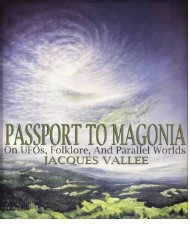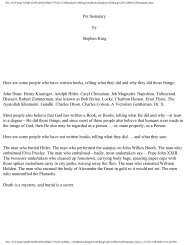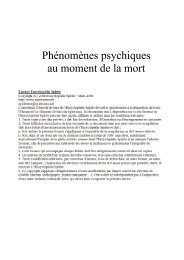extraordinary%20encounters
extraordinary%20encounters
extraordinary%20encounters
Create successful ePaper yourself
Turn your PDF publications into a flip-book with our unique Google optimized e-Paper software.
ported account ushered in the UFO age. The<br />
same afternoon as Arnold’s sighting, Oregon<br />
farmer Bill Schuening claimed to have seen a<br />
spherical object hovering five or six feet above<br />
a field. Just beneath it were “two little guys in<br />
green suits with white helmets” (McCune,<br />
1987). They were no more than three feet tall.<br />
A few seconds later they vanished. Schuening<br />
did not see them enter the craft, which then<br />
flew off toward the Cascades.<br />
In the early UFO era, however, such reports,<br />
relatively rare but hardly nonexistent,<br />
received little attention. In 1950, when the<br />
first book with “flying saucers” in its title,<br />
Donald E. Keyhoe’s paperback The Flying<br />
Saucers Are Real, saw print, the occupants of<br />
the vehicles—Keyhoe believed them to be<br />
peaceable extraterrestrials who deliberately refrained<br />
from contact—could only be speculated<br />
about. Another book published that<br />
same year, Frank Scully’s Behind the Flying<br />
Saucers, asserted that the U.S. government<br />
had recovered crashed spacecraft, containing<br />
the bodies of little men “dressed in the style of<br />
the 1890s” and believed to be from Venus.<br />
(Subsequent investigations determined that<br />
two veteran confidence artists had concocted<br />
these tales in order to peddle bogus oil-detection<br />
devices tied to advanced extraterrestrial<br />
technology.) Scully’s notorious book had the<br />
effect of leading some early ufologists—as opposed<br />
to the saucerians who embraced the<br />
contactee movement—to shy away from any<br />
reports of humanoids, whatever the source.<br />
A significant proportion of the reports described<br />
the occupants as humanoids. The specific<br />
descriptions may have varied, but witnesses<br />
mostly testified that UFO occupants<br />
had two arms, two legs, and generally humanlike<br />
head and facial features. Usually the beings<br />
were small. Sometimes they were<br />
grotesque-looking. Sometimes they looked<br />
like small humans. A minority were of normal<br />
human height, and a few were said to be more<br />
than that, seven or eight feet tall. Such reports<br />
came from all over the world, including remote<br />
Third World locations where UFOs<br />
were little known and the occupants were<br />
Close encounters of the third kind 63<br />
sometimes taken to be American or Russian<br />
pilots. A wave of humanoid and other encounters<br />
in France in the fall of 1954 received<br />
international attention and caused even the<br />
most cautious UFO researchers to reconsider<br />
their bias against CE3 reports. In the summer<br />
of 1955, the air force’s Project Blue Book investigated<br />
a bizarre episode in which members<br />
of a rural Kentucky family claimed to have<br />
spent a night besieged by floating, big-eared<br />
humanoid entities from a UFO.<br />
CE3s were different from the contact<br />
claims of George Adamski, Howard Menger,<br />
George Van Tassel, and other 1950s contactees<br />
in some important ways. For one, the<br />
beings seldom looked much like the goldenhaired,<br />
angelic spacemen and spacewomen<br />
who figured in the contactees’ tales. For another,<br />
they had little if anything to say. Communication,<br />
if any (and there seldom was),<br />
was brief, sometimes enigmatic, and always<br />
devoid of inspirational content. Unlike contactees,<br />
CE3 witnesses fit the profile of witnesses<br />
to less exotic UFO phenomena; in<br />
other words, they were ordinary citizens without<br />
a background in occultism and other esoteric<br />
pursuits, as contactees tended to be.<br />
They also did not embark on lecture tours or<br />
write books, as the more flamboyant contactees<br />
did.<br />
A spectacular CE3 took place over Boianai,<br />
Papua New Guinea, in late June 1959. The<br />
best-known witness, the Rev. William Booth<br />
Gill, was an Anglican missionary from Australia.<br />
On the evening of June 26, thirty-eight<br />
persons observed a large, disc-shaped craft<br />
with four legs hovering in the northwestern<br />
sky. Gill estimated its apparent size to be that<br />
of five full moons lined up end to end. At the<br />
top of the UFO, behind a glass-covered cockpit,<br />
four humanlike figures, surrounded by illumination,<br />
moved back and forth, apparently<br />
working at an unknown task. The object<br />
and its crew ascended into gathering clouds<br />
after forty-five minutes. Other UFOs, though<br />
not their occupants, were intermittently visible<br />
over the next three and a half hours.<br />
Twenty five of the witnesses signed a state-





